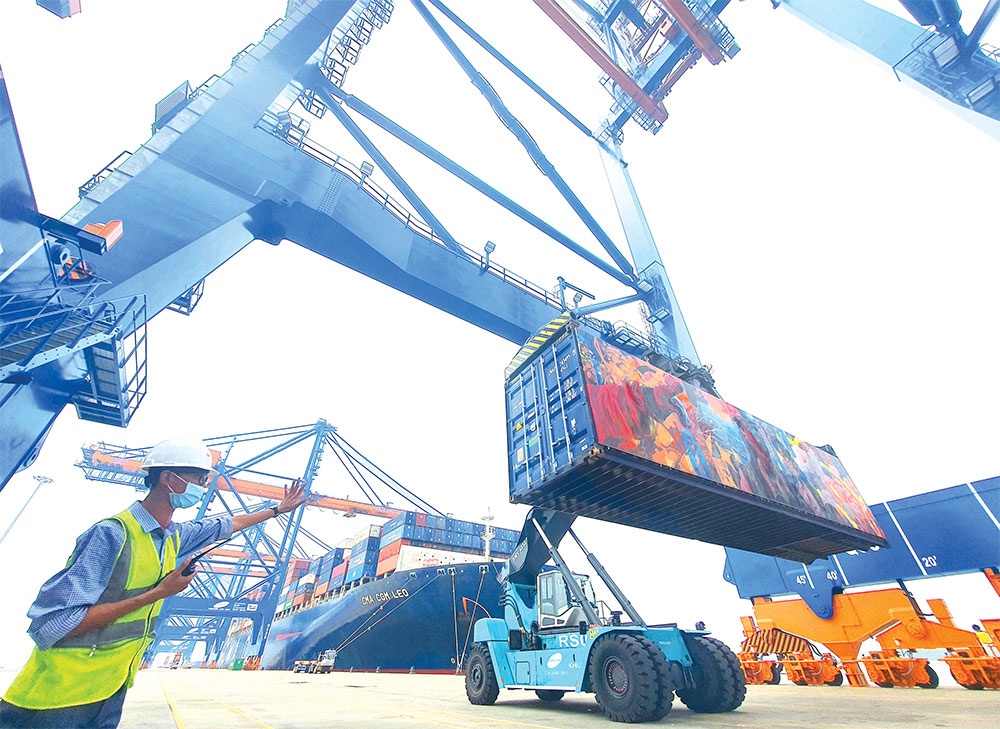Exporters seeking to retain competitive edge
In the third quarter of 2022, Thanh Cong Textile JSC (TCM) has received many orders for the year-end shopping season. But the outlook for orders for the fourth quarter and the first half of 2023 is not as positive, with buyers concerned about inflation and high inventories.
 |
| Exporters seeking to retain competitive edge, Photo Le Toan |
In 2022, TCM wants to reach $175 million in revenue and $10.6 million in profit after tax, up 18 and 76 per cent, respectively, compared to the previous year.
Chairman Tran Nhu Tung said, “We are working with customers to increase the selling price in proportion to the increase in input material prices with the expectation that profit margin will not be affected too much.”
The gloomy order outlook has caused Vietnam’s textile and garment exports to drop by nearly $1 billion compared to August. In its October report, SSI Securities recommended investors “reduce weight on stocks in textiles.” According to SSI, textile and garment enterprises are affected by the decrease in the USD/VND exchange rate. Although most textile companies record revenues in US dollars, many expenses are also calculated in that currency, such as costs related to materials, logistics, and interest expenses.
Therefore, in the second quarter, many companies recorded a significant increase in exchange rate losses, leading to financial loss when the USD/VND exchange rate fell by 2 per cent in the quarter.
SSI forecasts that orders will continue to be impacted by inflation and recession concerns until the first half of 2023. Orders are expected to improve by the end of the second quarter of 2023, if inflation eases. Although better input material prices will have a positive impact on gross margin, the average selling price is under downward pressure from retailers as the first half of 2022 is the period to record the business results of textile and garment makers. SSI forecasts these businesses will record reduced revenue and net losses in the first six months of 2023.
Le Tien Truong, chairman of Vietnam National Textile and Garment Group, commented, “I’m concerned that the country’s textile and garment exports have lost their competitive advantage compared to countries with depreciating currencies, such as India or China, due to the high value of the VND and Vietnam’s macroeconomic stability.”
In the last months of the year, it is expected that textile and garment exports will only be up to $3.2 billion per month, instead of $3.8 billion on average as in the first eight months of the year.
According to the General Statistics Office, in September, commodity exports decreased by 14.3 per cent compared to August, reaching $29.94 billion. However, thanks to high export growth in the previous eight months, in the first nine months, exports still recorded high growth, reaching $282.5 billion, up 17.3 per cent over the same period last year.
However, exchange rate pressure is still high at the end of the year, which will continue to negatively affect the results of businesses, especially those with high costs in US dollars, such as textiles and garments and seafood. Meanwhile, analysts do not exclude the possibility that the State Bank of Vietnam (SBV) will continue to increase operating interest rates to reduce pressure on the exchange rate.
The central US dollar exchange rate on the morning of October 3 was announced by the SBV at VND23,412 per US dollar, slightly up from last Friday’s session. The reference selling rate at the SBV’s Transaction Office was maintained at a new level of VND23,925 per US dollar.
Thus, within a month, the SBV raised the USD selling rate twice while the supply and demand of foreign currencies in the market had not improved much.
The recent strong increase in the US dollar price has caused many fluctuations for the market. Banks have increased the US dollar price to the highest level in history, above VND24,000 per US dollar, up nearly 5 per cent compared to the beginning of the year. At the trading session on October 3, the selling price of the US dollar at VietinBank was VND24,016, while Vietcombank offered VND24,000 and Eximbank VND24,015. Up to now, the US dollar is still the main payment currency for about 60-70 per cent of Vietnam’s import and export contracts.
Dr. Le Xuan Nghia, former vice chairman of the National Financial and Monetary Policy Advisory Council, said that the appreciation of the US dollar caused the VND to depreciate. This pressure will continue through mid-2023 or even longer.
“In case of large fluctuations in the exchange rate, the SBV will use foreign currency reserves, helping the exchange rate return to stability, as it has done in the last two quarters,” Nghia said. However, he recommended that businesses should “proactively respond to exchange rate issues and pay attention to exchange rates between VND and foreign trade payment currencies to choose export and import markets and the most profitable payment currency.”
| Nguyen Thi Hong-Governor State Bank of Vietnam
The consistent goal of monetary policy is to ensure inflation control, macroeconomic stability, and safe operation of credit institutions. Therefore, the regulation of credit granting conditions is necessary to ensure credit quality and control arising of bad debts, and it is necessary to carefully consider easing these conditions. In 2022, credit growth is expected to be around 14 per cent. In order to increase access to capital, in addition to solutions from the banking industry, there needs to be synchronous coordination from other policies on removing difficulties for production and business according to the guidelines of the National Assembly and the government. When production and business activities are opened, a feasible business plan will create favourable conditions for businesses to access capital. Dr. Le Quoc Phuong-Former deputy director Industry and Trade Information Centre
Exchange rate fluctuations are affecting exports and disturbing business plans because they have to pay more to import goods, leading to higher product costs and affecting profits. This forces businesses to actively adjust and adapt. Businesses should not be too worried about the exchange rate as there has not been a specific assessment of how exchange rate fluctuations affect each market and export item. Vietnam’s economy is still mainly outsourcing and assembled, processed, and manufactured products account for nearly 90 per cent of exports. Therefore, exchange rate fluctuations are likely to affect import prices, but the damage will not be too great. Dinh Quang Hinh-Head of Macroeconomics and Market Strategy VNDIRECT Securities JSC
With the Fed maintaining its interest rate hike schedule, the exchange rate will continue to be under pressure in the final months of 2022 due to the high US dollar anchor. Even so, there are still factors supporting the exchange rate, including stronger overseas investment inflows, an improved trade surplus, balance of payments surplus, and foreign exchange reserves reaching the safe threshold. VNDIRECT forecasts that the VND may depreciate by 3.5-4 per cent against the US dollar in 2022. In 2023, we expect the pressure on Vietnam’s exchange rate to cool down significantly and forecast that the VND will appreciate against the US dollar in 2023 due to the Fed’s shift from tightening monetary policy to normalising it next year. |
| -The total export and import turnover of goods in the first nine months of 2022 has surpassed the $500 billion mark, estimated at $558.52 billion, up 15.1 per cent over the same period last year, with a trade surplus of $6.52 billion. -After the first nine months of 2022, export growth was recorded in both the domestic economic sector and the foreign direct one, with an increase of 16.4 and 17.6 per cent, respectively. -In a report sent to the Economic Committee of the National Assembly, the Ministry of Industry and Trade forecast that exports in 2022 are estimated at about $368 billion, an increase of about 9.46 per cent compared to 2021, exceeding the target assigned by the government of about 8 per cent. |
 | Inflation risks pose questions for exchange rate policy In response to the recent Fed’s interest rate hike, the State Bank of Vietnam is predicted to tighten its monetary policy in an attempt to curb inflation, with a focus on controlling the exchange rate. |
 | Reference exchange rate down 18 VND The State Bank of Vietnam set the daily reference exchange rate for the US dollar at 23,263 VND/USD on September 9, down 18 VND from the previous day. |
What the stars mean:
★ Poor ★ ★ Promising ★★★ Good ★★★★ Very good ★★★★★ Exceptional
Related Contents
Latest News
More News
- Businesses ramp up production as year-end orders surge (December 30, 2025 | 10:05)
- Vietjet chairwoman awarded Labour Hero title (December 29, 2025 | 13:06)
- How to unlock ESG value through green innovation (December 29, 2025 | 10:03)
- AI reshapes media and advertising industry (December 29, 2025 | 08:33)
- FPT and GELEX sign deal to develop blockchain tech for global markets (December 29, 2025 | 08:29)
- Vietnam’s GDP forecast to grow by 9 per cent in 2026 (December 29, 2025 | 08:29)
- Women entrepreneurs are key to Vietnam’s economic growth (December 29, 2025 | 08:00)
- Vietnam's top 500 value-creating enterprises announced (December 27, 2025 | 08:00)
- The PAN Group shaping a better future with ESG strategy (December 26, 2025 | 09:00)
- Masan Consumer officially lists on HSX, marking the next phase of value creation (December 25, 2025 | 13:20)




 Tag:
Tag:





















 Mobile Version
Mobile Version